The Plasma Spectroscopic Study of Dergaon Meteorite, India
Abstract
1. Introduction
2. Results and Discussion
- (i)
- optically thin plasma,
- (ii)
- stoichiometric ablation, and
- (iii)
- thermal equilibrium.
2.1. Optically Thin Plasma
2.2. Stoichiometric Ablation
2.3. Local Thermodynamic Equilibrium (LTE)
2.4. Species Concentrations
- (1)
- Find the area under of measured spectral lines of elements.
- (2)
- Infer temperature by constructing a Boltzmann plot.
- (3)
- Determine the intercept of the Boltzmann plot for each species.
- (4)
- Calculate the partition function for each species.
- (5)
- Evaluate the experimental efficiency factor, F, in Eq. (1), by normalizing the sum of the relative concentrations of all species in the sample, i.e., ∑Cs = 1
- (6)
- Finally, conclude species concentrations.
3. Materials and Methods
Experimental Arrangement
4. Conclusions
Author Contributions
Funding
Acknowledgments
Conflicts of Interest
References
- Bennett, M.E.; Mcsween, H.Y. Revised model calculations for the thermal histories of ordinary chondrite parent bodies. Meteorit. Planet. Sci. 1996, 31, 783–792. [Google Scholar] [CrossRef]
- Shukla, P.N.; Shukla, A.D.; Rai, V.K.; Murty, S.V.S.; Bhandari, N.; Goswami, J.N.; Mazumdar, A.C.; Phukon, P.; Duorah, K.; Greenwood, R.E.; et al. The Dergaon (H5) Chondrite: Fall, Classification, Petrological and Chemical Characteristics, Cosmogenic Effects, and Noble Gas Records. Meteorit. Planet. Sci. 2005, 40, 627–637. [Google Scholar] [CrossRef]
- Ray, D.; Ghosh, S.; Goswami, T.K.; Jobin, M.J. Insights into chondrule formation process and shock-thermal history of the Dergaon chondrite (H4-5). Geosci. Front. 2017, 8, 413–423. [Google Scholar] [CrossRef]
- Barua, A.G.; Boruah, B.R.; Bhattacharyya, S.; Baruah, G.D. Spectroscopic investigation of the Dergaon meteorite with reference to 10 mm and 20 mm bands. Pramana 2003, 60, 47–52. [Google Scholar] [CrossRef]
- Bhattacharyya, S.; Barua, A.G.; Konwar, R.; Changmai, R.; Baruah, G.D. Nature of the Emission Band of Dergaon Meteorite in the Region 5700–6700 Å. Pramana 2004, 62, 1299–1301. [Google Scholar] [CrossRef]
- Saikia, B.J.; Parthasarathy, G.; Sarmah, N.C.; Baruah, G.D. Organic compounds in H5 meteorite: Spectroscopic investigation of Dergaon H5 chondrite. Geochim. Cosmochim. Acta 2009, 71, 867–882. [Google Scholar]
- Saikia, B.J.; Parthasarathy, G. Spectroscopy of Dergaon meteorite. Geochim. Cosmochim. Acta 2008, 72, 818–828. [Google Scholar]
- Saikia, B.J.; Parthasarathy, G.; Sarmah, N.C. Fourier transform infrared spectroscopic characterization of Dergaon H5 chondrite: Evidence of aliphatic organic compound. Nat. Sci. 2009, 7, 45–51. [Google Scholar]
- Saikia, B.J.; Parthasarathy, G.; Sarmah, N.C. Spectroscopic characterization of olivine [(Fe,Mg)2SiO4] in Mahadevpur H4/5 ordinary chondrite. J. Am. Sci. 2009, 5, 71–78. [Google Scholar]
- Saikia, B.J.; Parthasarathy, G.; Borah, R.R. Nanodiamonds and silicate minerals in ordinary chondrites as determined by micro-Raman spectroscopy Meteorit. Planet Sci. 2017, 52, 1146–1154. [Google Scholar] [CrossRef]
- Ciucci, A.; Corsi, M.; Palleschi, V.; Rastelli, S.; Salvetti, A.; Tognoni, E. New Procedure for Quantitative Elemental Analysis by Laser-Induced Plasma Spectroscopy. Appl. Spectrosc. 1999, 53, 960–964. [Google Scholar] [CrossRef]
- De Giacomo, A.; Dell’Aglio, M.; De Pascale, O.; Longo, S.; Capitelli, M. Laser induced breakdown spectroscopy on meteorites. Spectrochim. Acta Part B: At. Spectrosc. 2007, 62, 1606–1611. [Google Scholar] [CrossRef]
- Dell’Aglio, M.; De Giacomo, A.; Gaudiuso, R.; Pascale, O.D.; Senesi, G.S.; Longo, S. Laser Induced Breakdown Spectroscopy applications to meteorites: Chemical analysis and composition profiles. Geochim. Cosmochim. Acta 2010, 74, 7329–7339. [Google Scholar] [CrossRef]
- Cousin, A.; Sautter, V.; Fabre, C.; Maurice, S.; Wiens, R.C. Textural and modal analyses of picritic basalts with ChemCam laser-induced breakdown spectroscopy. J. Geophys. Res. 2012, 117, E10002. [Google Scholar] [CrossRef]
- Horňáčková, M.; Plavčan, J.; Rakovský, J.; Porubčan, V.; Ozdín, D.; Veis, P. Calibration-free laser induced breakdown spectroscopy as an alternative method for found meteorite fragments analysis. Eur. Phys. J. 2014, 66, 10702. [Google Scholar]
- Senesi, G.S.; Manzari, P.; Tempesta, G.; Agrosì, G.; Touchnt, A.A.; Ibhi, A.; De Pascale, O. Handheld Laser Induced Breakdown Spectroscopy Instrumentation Applied to the Rapid Discrimination between Iron Meteorites and Meteor-Wrongs. Geostand. Geoanalytical. Res. 2018, 42, 607–614. [Google Scholar] [CrossRef]
- Pandhija, S.; Rai, N.K.; Rai, A.K.; Thakur, S.N. Contaminant concentration in environmental samples using LIBS and CF-LIBS. Appl. Phys. B 2009, 98, 231–241. [Google Scholar] [CrossRef]
- Koeberl, C.; Shirey, S.B. Detection of a Meteoritic Component in Ivory Coast Tektites with Rhenium-Osmium Isotopes. Science 1993, 261, 595–598. [Google Scholar] [CrossRef]
- Tagle, R.; Hecht, L. Geochemical identification of projectiles in impact rocks. Meteorit. Planet. Sci. 2006, 41, 1721–1735. [Google Scholar] [CrossRef]
- Misra, S.; Newsom, H.E.; Prasad, M.S.; Geissman, J.W.; Dube, A.; Sengupta, D. Geochemical identification of impactor for Lonar crater, India. Meteorit. Planet. Sci. 2009, 44, 1001–1018. [Google Scholar] [CrossRef]
- Pati, J.K.; Qu, W.J.; Koeberl, C.; Reimold, W.U.; Chakarvorty, M.; Schmitt, R.T. Geochemical evidence of an extraterrestrial component in impact melt breccia from the PaleoproterozoicDhala impact structure. India Meteorit. Planet. Sci. 2017, 52, 722–736. [Google Scholar] [CrossRef]
- Rai, A.K.; Pati, J.K.; Kumar, R. Spectro-chemical study of moldavites from Ries impact structure (Germany) using LIBS. Opt. Laser Technol. 2019, 114, 146–157. [Google Scholar] [CrossRef]
- National Institute of Standards and Technology (NIST) Electronic Database. Available online: http://physics.nist.gov/PhysRefData/ASD/linesform.html (accessed on 26 October 2019).
- Nachon, M.; Clegg, S.M.; Mangold, N.; Schröder, S.; Kah, L.C.; Dromart, G.; Ollila, A.; Johnson, J.R.; Oehler, D.Z.; Bridges, J.C.; et al. Calcium sulfate veins characterized by ChemCam/Curiosity at Gale crater, Mars. J. Geophys. Res. Planets 2014, 119, 1991–2016. [Google Scholar] [CrossRef]
- Rai, A.K.; Pati, J.K.; Parigger, C.G.; Rai, A.K. Plasma Spectroscopy of Various Types of Gypsum: An Ideal Terrestrial Analogue. Atoms 2019, 7, 72. [Google Scholar] [CrossRef]
- Cheung, A.-C.; Lyyra, A.; Merer, A.; Taylor, A. Laser spectroscopy of FeO: Rotational analysis of some subbands of the orange system. J. Mol. Spectrosc. 1983, 102, 224–257. [Google Scholar] [CrossRef]
- Cremers, D.A.; Radziemski, L.J. Handbook of Laser-Induced Breakdown Spectroscopy; John Wiley: Chichester, UK, 2013. [Google Scholar]
- Kumar, R.; Rai, A.K.; Alamelu, D.; Aggarwal, S.K. Monitoring of toxic elements present in sludge of industrial waste using CF-LIBS. Environ. Monit. Assess. 2012, 185, 171–180. [Google Scholar] [CrossRef] [PubMed]
- Thakur, S.N. Atomic emission spectroscopy. In Laser Induced Breakdown Spectroscopy; Singh, J.P., Thakur, S.N., Eds.; Elsevier: Amsterdam, NL, 2007; pp. 23–48. [Google Scholar]
- Singh Maurya, G.; Jyotsana, A.; Kumar, R.; Kumar, A.; Rai, A.K. Analysis of Deposited impurity material on the surface of optical window of the Tokamak using LIBS. Phys. Scr. 2014, 89, 075601. [Google Scholar] [CrossRef]
- Griem, H.R. Plasma Spectroscopy; McGraw-Hill: New York, NY, USA, 1964. [Google Scholar]
Sample Availability: Samples of the compounds are available from the authors. |
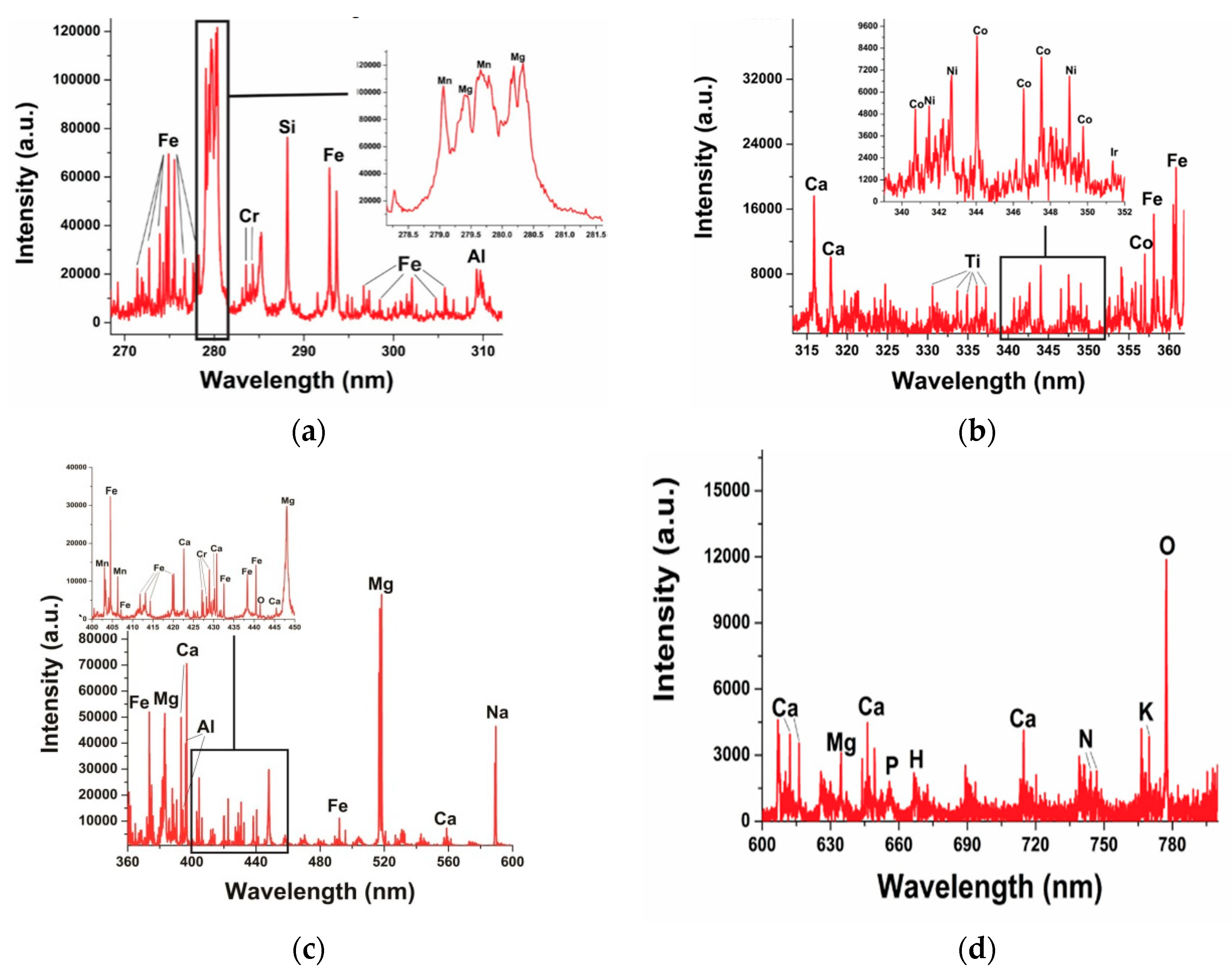
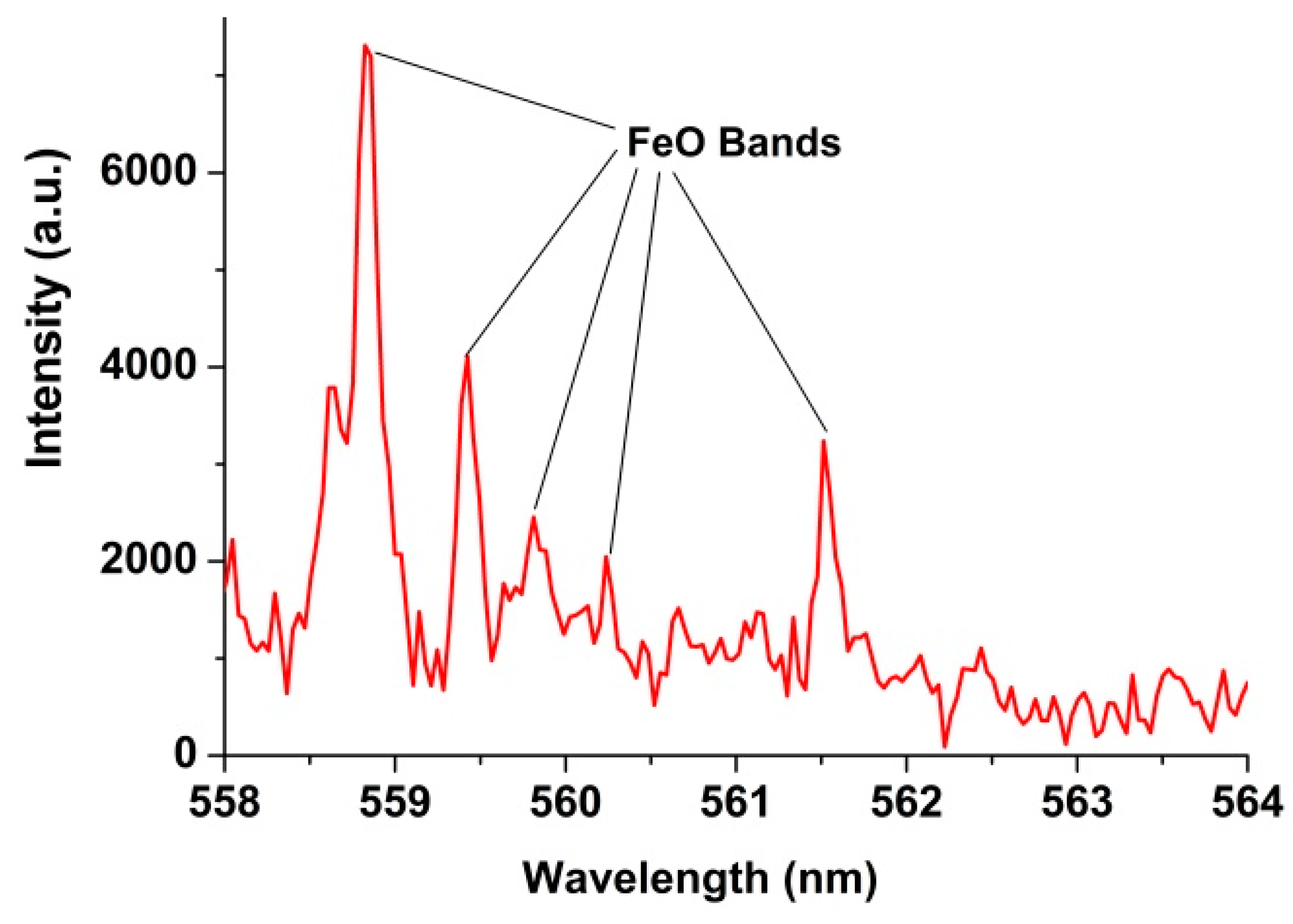
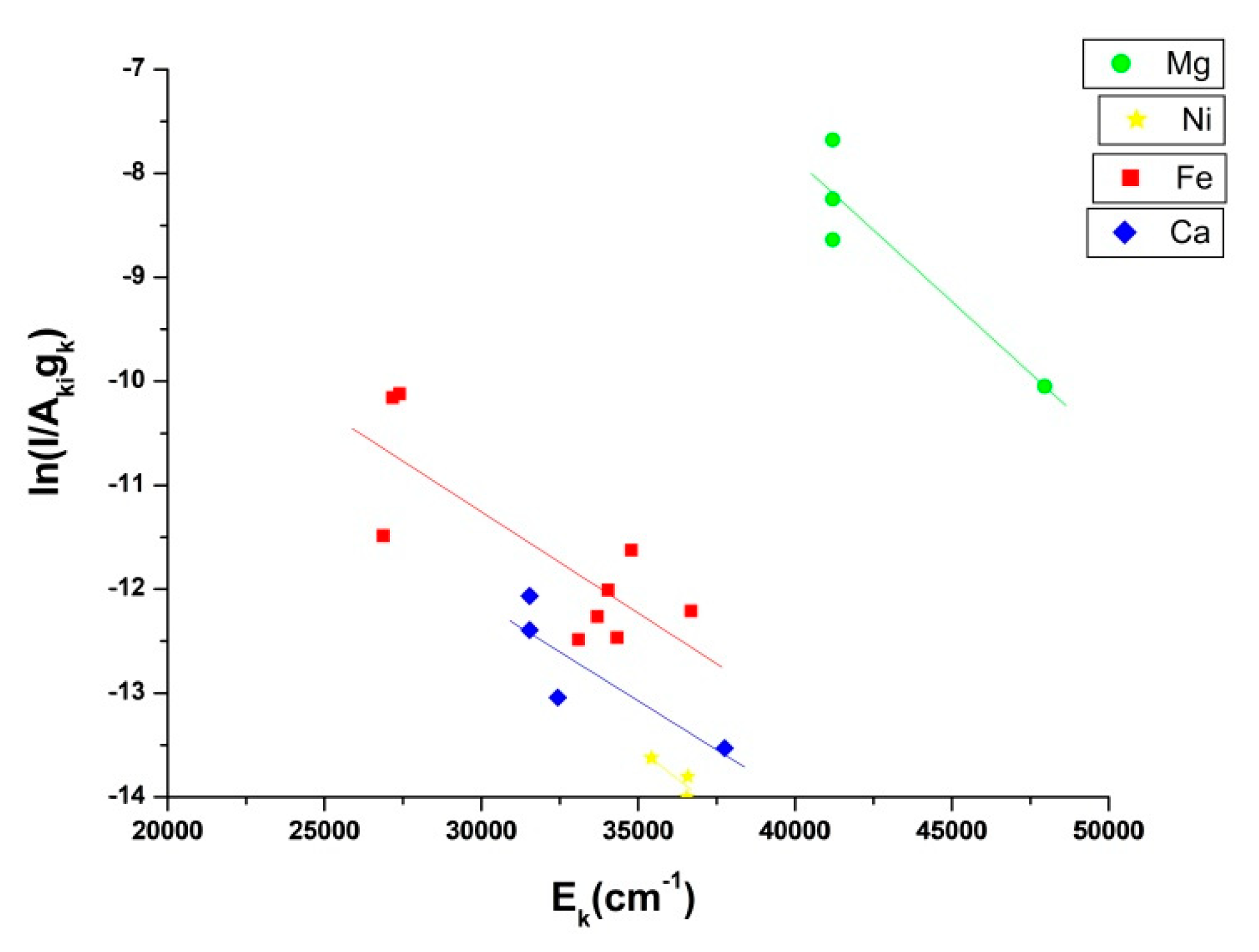
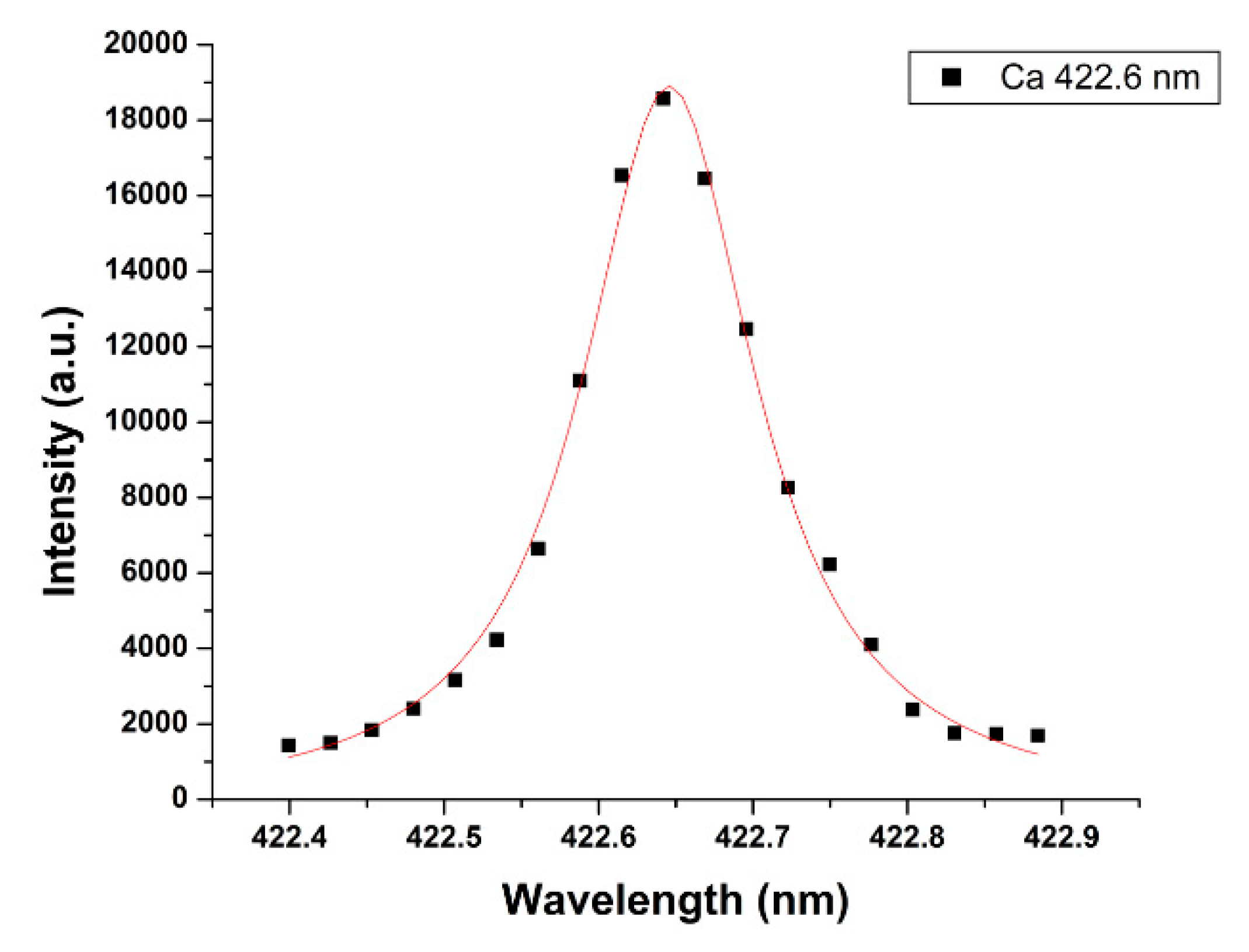
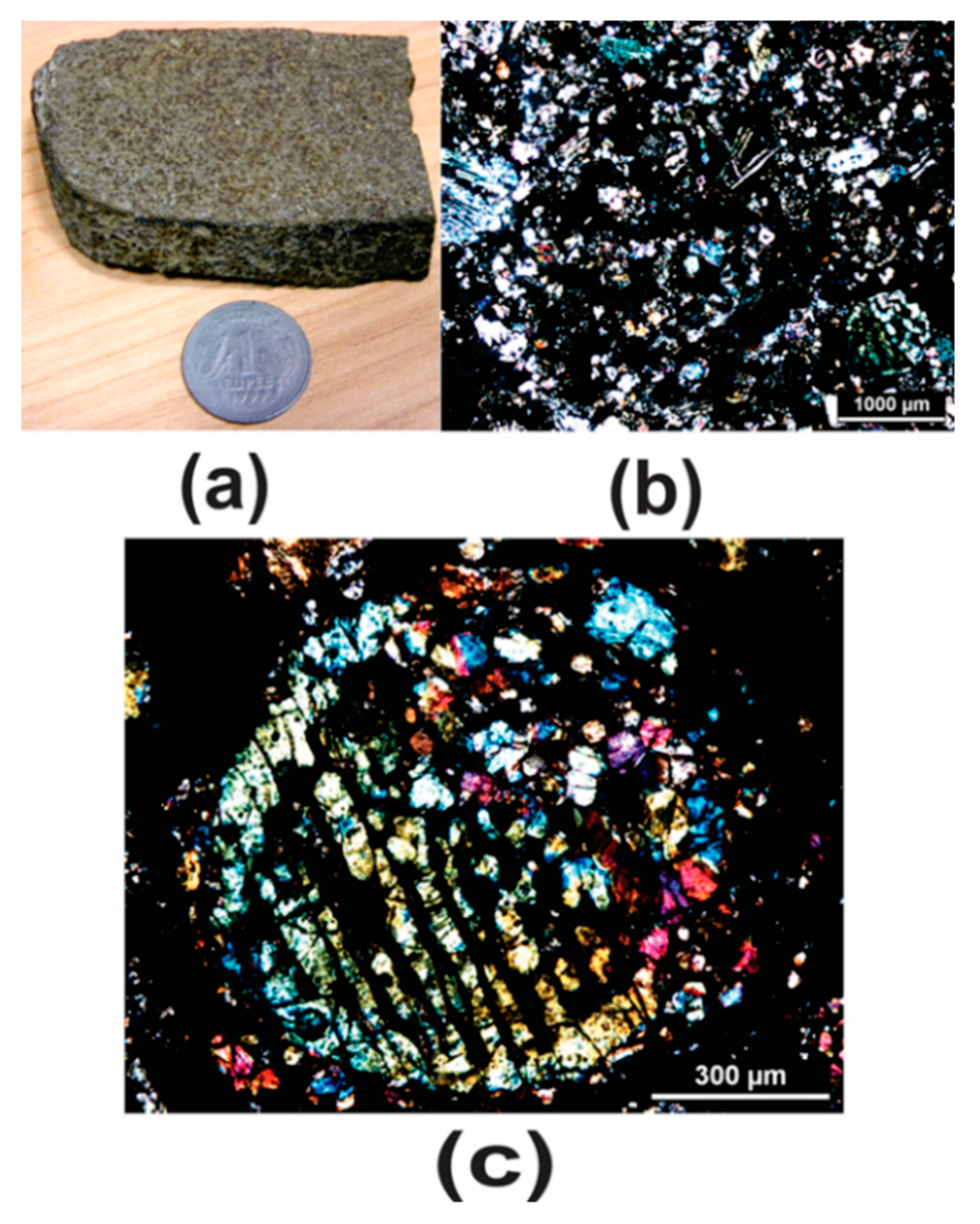
| Species | Major Lines (nm) Present in Dergaon Meteorite |
|---|---|
| H (1) | 656.3(I) |
| N (7) | 744.2(I), 746.8(I), 868.3(I) |
| O (8) | 777.4(I), 844.6(I), 926.6(I) |
| Na (11) | 588.9(I), 589.5(I) |
| Mg (12) | 279.0(II), 279.5(II), 280.2(II),285.2(I), 382.9(I), 383.2(I), 383.8(I), 448.1(II), 516.7(I), 517.2(I), 518.3(I) |
| Al (13) | 308.2(I), 309.2(I), 394.3(I), 396.1(I) |
| Si (14) | 220.7(I), 221.0(I), 221.6(I), 250.6(I), 251.4(I), 251.6(I), 251.9(I), 252.8(I), 288.1(I), 390.5(I), 413.1(II),557.6(II), 634.7(II) |
| P (15) | 645.9(II), 650.3(II), 650.7(II) |
| K (19) | 766.4(I), 769.8(I) |
| Ca (20) | 315.8(II), 317.9(II), 370.6(II), 373.6(II), 393.2(II), 396.7(II), 370.5(II), 422.6(I), 430.2(I), 442.5(I), 443.9(I), 445.4(I), 501.9(II), 518.8(I), 558.7(I), 610.2(I), 612.2(I), 616.2(I), 645.6(II), 646.2(I), 649.5(I), 647.2(I), 720.1(I) |
| Ti (22) | 334.9(II), 336.1(II) |
| Cr (24) | 283.5(II), 284.3(II), 284.9.(II), 302.0(I), 359.3(I), 360.5(I), 369.5(I), 381.5(I), 385.5(I), 428.9(I) |
| Mn (25) | 257.6(II), 279.4(I), 279.8(I), 280.1(I), 380.6(I), 403.0(I), 403.3(I), 403.4(I) |
| Fe (26) | 234.3(II), 238.2(II), 239.5(II), 240.4(II), 249.3(II), 250.7(II), 252.4(I), 254.3(II), 256.7(II), |
| 258.5(II), 259.8(II), 259.9(II), 260.7(II), 261.1(II), 273.9(II), 274.9(II), 275.5(II), 293.6(I), | |
| 305.7(I), 305.9(I), 344.0(I), 358.0(I), 358.1(I), 364.7(I), 371.9(I), 373.4(I), 373.7(I), | |
| 374.5(I), 374.9(I), 375.8(I), 382.0(I), 385.9(I), 404.1(I), 404.5(I), 406.3(I), 432.5(I), 438.3 (I) | |
| Co (27) | 340.5(I), 344.3(I), 347.3(I), 349.5 (I) |
| Ni (28) | 338.0(I), 341.3(I), 342.3(I), 349.2(I),352.4(I) |
| Ir (77) | 351.3(I) |
| Species | Intensity Ratio, I/I′ (Experimental) | |
|---|---|---|
| Fe-I (374.9/375.8) | 1.59 | 1.43 ± 0.02 |
| Ca-II (315.8/317.9) | 0.57 | 0.55 ± 0.01 |
| Ca-11 (393.3/375.8) | 2.06 | 1.99±0.04 |
| Mg-II (279.5/280.2) | 2.05 | 2.09 ± 0.05 |
| Cr-I (359.3/360.5) | 1.30 | 1.22±0.07 |
| Species | INAA, AAS and ICP-AES * (wt %) | XRF **(wt %) | CF-LIBS *** (wt %) |
|---|---|---|---|
| H | - | - | 0.27 |
| N | - | - | 0.69 |
| O | - | - | 33.50 |
| Na | 0.7061 | 0.670 | 0.77 |
| Mg | 13.6 | 14.26 | 13.44 |
| Al | 1.09 | 1.20 | 1.70 |
| Si | - | 17.30 | 17.42 |
| K | 0.03 | 0.067 | 0.09 |
| Ca | 1.08 | 1.19 | 1.77 |
| Ti | - | 0.04 | 0.07 |
| Cr | 0.3705 | 0.03 | 0.55 |
| Mn | 0.2329 | - | 0.31 |
| Fe | 27.3 | 27.73 | 27.90 |
| Co | 0.08 | - | 0.07 |
| Ni | 1.82 | 1.75 | 1.30 |
© 2020 by the authors. Licensee MDPI, Basel, Switzerland. This article is an open access article distributed under the terms and conditions of the Creative Commons Attribution (CC BY) license (http://creativecommons.org/licenses/by/4.0/).
Share and Cite
Rai, A.K.; Pati, J.K.; Parigger, C.G.; Dubey, S.; Rai, A.K.; Bhagabaty, B.; Mazumdar, A.C.; Duorah, K. The Plasma Spectroscopic Study of Dergaon Meteorite, India. Molecules 2020, 25, 984. https://doi.org/10.3390/molecules25040984
Rai AK, Pati JK, Parigger CG, Dubey S, Rai AK, Bhagabaty B, Mazumdar AC, Duorah K. The Plasma Spectroscopic Study of Dergaon Meteorite, India. Molecules. 2020; 25(4):984. https://doi.org/10.3390/molecules25040984
Chicago/Turabian StyleRai, Abhishek K., Jayanta K. Pati, Christian G. Parigger, Sonali Dubey, Awadhesh K. Rai, Balen Bhagabaty, Amulya C. Mazumdar, and Kalpana Duorah. 2020. "The Plasma Spectroscopic Study of Dergaon Meteorite, India" Molecules 25, no. 4: 984. https://doi.org/10.3390/molecules25040984
APA StyleRai, A. K., Pati, J. K., Parigger, C. G., Dubey, S., Rai, A. K., Bhagabaty, B., Mazumdar, A. C., & Duorah, K. (2020). The Plasma Spectroscopic Study of Dergaon Meteorite, India. Molecules, 25(4), 984. https://doi.org/10.3390/molecules25040984








